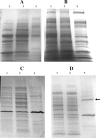Inactivation of traP has no effect on the agr quorum-sensing system or virulence of Staphylococcus aureus
- PMID: 17548478
- PMCID: PMC1951194
- DOI: 10.1128/IAI.00491-07
Inactivation of traP has no effect on the agr quorum-sensing system or virulence of Staphylococcus aureus
Abstract
The success of Staphylococcus aureus as a pathogen can largely be attributed to the plethora of genetic regulators encoded within its genome that temporally regulate its arsenal of virulence determinants throughout its virulence lifestyle. Arguably the most important of these is the two-component, quorum-sensing system agr. Over the last decade, the controversial presence of a second quorum-sensing system (the TRAP system) has been proposed, and it has been mooted to function as the master regulator of virulence in S. aureus by modulating agr. Mutants defective in TRAP are reported to be devoid of agr expression, lacking in hemolytic activity, essentially deficient in the secretion of virulence determinants, and avirulent in infection models. A number of research groups have questioned the validity of the TRAP findings in recent years; however, a thorough and independent analysis of its role in S. aureus physiology and pathogenesis has not been forthcoming. Therefore, we have undertaken such an analysis of the TRAP locus of S. aureus. We found that a traP mutant was equally hemolytic as the wild-type strain. Furthermore, transcriptional profiling found no alterations in the traP mutant in expression levels of agr or in expression levels of multiple agr-regulated genes (hla, sspA, and spa). Analysis of secreted and surface proteins of the traP mutant revealed no deviation in comparison to the parent. Finally, analysis conducted using a murine model of S. aureus septic arthritis revealed that, in contrast to an agr mutant, the traP mutant was just as virulent as the wild-type strain.
Figures




Similar articles
-
Global virulence regulation in Staphylococcus aureus: pinpointing the roles of ClpP and ClpX in the sar/agr regulatory network.Infect Immun. 2005 Dec;73(12):8100-8. doi: 10.1128/IAI.73.12.8100-8108.2005. Infect Immun. 2005. PMID: 16299304 Free PMC article.
-
Coordinated and differential control of aureolysin (aur) and serine protease (sspA) transcription in Staphylococcus aureus by sarA, rot and agr (RNAIII).Int J Med Microbiol. 2006 Oct;296(6):365-80. doi: 10.1016/j.ijmm.2006.02.019. Epub 2006 Jun 19. Int J Med Microbiol. 2006. PMID: 16782403
-
Treatment of Staphylococcus aureus biofilm infection by the quorum-sensing inhibitor RIP.Antimicrob Agents Chemother. 2007 Jun;51(6):2226-9. doi: 10.1128/AAC.01097-06. Epub 2007 Mar 19. Antimicrob Agents Chemother. 2007. PMID: 17371825 Free PMC article.
-
Quorum sensing-mediated regulation of staphylococcal virulence and antibiotic resistance.Future Microbiol. 2014;9(5):669-81. doi: 10.2217/fmb.14.31. Future Microbiol. 2014. PMID: 24957093 Review.
-
What role does the quorum-sensing accessory gene regulator system play during Staphylococcus aureus bacteremia?Trends Microbiol. 2014 Dec;22(12):676-85. doi: 10.1016/j.tim.2014.09.002. Epub 2014 Oct 6. Trends Microbiol. 2014. PMID: 25300477 Review.
Cited by
-
Structure of the signal transduction protein TRAP (target of RNAIII-activating protein).Acta Crystallogr Sect F Struct Biol Cryst Commun. 2012 Jul 1;68(Pt 7):744-50. doi: 10.1107/S1744309112020167. Epub 2012 Jun 22. Acta Crystallogr Sect F Struct Biol Cryst Commun. 2012. PMID: 22750855 Free PMC article.
-
Proteomic Profiles of Staphylococcus aureus Strains Associated with Subclinical Bovine Mastitis.Curr Microbiol. 2022 Feb 12;79(4):101. doi: 10.1007/s00284-022-02796-7. Curr Microbiol. 2022. PMID: 35150342
-
Medicinal chemistry as a conduit for the modulation of quorum sensing.J Med Chem. 2010 Nov 11;53(21):7467-89. doi: 10.1021/jm901742e. J Med Chem. 2010. PMID: 20669927 Free PMC article. No abstract available.
-
Quorumpeps database: chemical space, microbial origin and functionality of quorum sensing peptides.Nucleic Acids Res. 2013 Jan;41(Database issue):D655-9. doi: 10.1093/nar/gks1137. Epub 2012 Nov 24. Nucleic Acids Res. 2013. PMID: 23180797 Free PMC article.
-
Attenuating Staphylococcus aureus virulence gene regulation: a medicinal chemistry perspective.J Med Chem. 2013 Feb 28;56(4):1389-404. doi: 10.1021/jm3014635. Epub 2013 Jan 22. J Med Chem. 2013. PMID: 23294220 Free PMC article.
References
-
- Anguita-Alonso, P., A. Giacometti, O. Cirioni, R. Ghiselli, F. Orlando, V. Saba, G. Scalise, M. Sevo, R. Patel, and N. Balaban. 2007. RNAIII-inhibiting peptide-loaded polymethylmethacrylate prevents in vivo Staphylococcus aureus biofilm formation. Antimicrob. Agents Chemother. 51:2594-2596. - PMC - PubMed
-
- Arvidson, S., and K. Tegmark. 2001. Regulation of virulence determinants in Staphylococcus aureus. Int. J. Med. Microbiol. 291:159-170. - PubMed
-
- Balaban, N., L. V. Collins, J. S. Cullor, E. B. Hume, E. Medina-Acosta, O. Vieira da Motta, R. O'Callaghan, P. V. Rossitto, M. E. Shirtliff, L. Serafim da Silveira, A. Tarkowski, and J. V. Torres. 2000. Prevention of diseases caused by Staphylococcus aureus using the peptide RIP. Peptides 21:1301-1311. - PubMed
Publication types
MeSH terms
Substances
LinkOut - more resources
Full Text Sources
Other Literature Sources
Research Materials

